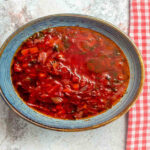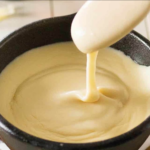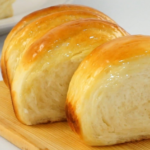Welcome to our blog! Today, we’re diving into the world of homemade Sandwich Bread Recipes. There’s nothing quite like the smell of fresh bread baking in your kitchen, and with this simple recipe, you can enjoy soft, delicious sandwich bread made right at home. Whether you’re looking to elevate your sandwiches or simply enjoy a slice with butter, this guide will walk you through everything you need to know.
What is Sandwich Bread?
Sandwich bread is a soft, rectangular loaf specifically designed for making sandwiches, toast, and various other dishes. Its uniform slices make it easy to layer ingredients, while its light texture allows for the absorption of spreads like butter or jam without falling apart.
The Origin of Sandwich Bread Recipe
The concept of bread dates back thousands of years, with evidence of early bread-making found in ancient Egypt. However, sandwich bread, as we know it today, gained popularity in the 18th century in the UK, thanks to John Montagu, the 4th Earl of Sandwich. Legend has it that he requested meat between two slices of bread, allowing him to eat without utensils. This convenient method quickly spread, leading to the term “sandwich” and the creation of the soft, sliced loaves we enjoy today.
Why is Sandwich Bread Famous?
Sandwich bread is celebrated for its versatility. It serves as the foundation for a myriad of meals, from classic sandwiches to gourmet creations. With the convenience of store-bought loaves and the wholesome flavor of homemade varieties, sandwich bread has become a staple in many kitchens around the world.

Sandwich Bread Recipe
Ingredients
Equipment
Method
- In a small basin, combine the warm water and sugar, then sprinkle the yeast on top. Allow it to settle for 5-10 minutes until it gets foamy. This step guarantees that the yeast is active.
- In a large mixing bowl, add the flour and salt, mixing well. Once the yeast is ready, pour it into the dry mixture along with the softened butter. If using a stand mixer, knead the dough with the dough hook attachment for about 5-7 minutes. If kneading by hand, mix until the dough comes together, then transfer it to a floured surface and knead for 10 minutes until smooth and elastic.
- Place the kneaded dough into a lightly oiled bowl, cover it with plastic wrap or a kitchen towel, and let it rise in a warm area for about 1-1.5 hours, or until it has doubled in size.
- Once the dough has risen, punch it down to expel any air bubbles. Place it on a lightly floured surface and shape it into a rectangle. Roll the dough tightly and place it in a prepared loaf pan.
- Cover the loaf with a towel and let it rise again for about 30-40 minutes, or until the dough has risen just above the top of the pan.
- Preheat the oven to 350°F (175° C). Once heated, bake the bread for 25-30 minutes, or until the top is golden brown and the loaf sounds hollow when tapped. Brush the top of the bread with milk before baking to create a softer crust.
- Remove the bread from the oven and allow to cool in the pan for 10 minutes. Then, place it on a cooling rack to cool entirely before slicing.
Notes
- Calories: 120 kcal
- Carbohydrates: 22g
- Protein: 3g
- Fat: 2g
- Fiber: 1g
- Sugar: 1g
- Sodium: 150mg
Equipment Needed
To make your own sandwich bread, you’ll need the following equipment:
- Mixing bowl
- Measuring cups and spoons
- Stand mixer (optional)
- Loaf pan (9×5 inch is standard)
- Oven
- Cooling rack
- Plastic wrap or a clean kitchen towel
Ingredients
Here’s what you’ll need to make delicious sandwich bread:
- 3 ½ cups of all-purpose flour (or bread flour).
- 2 ¼ teaspoons active dry yeast (1 packet)
- 1 ¼ cups warm water (110°F or 45°C)
- 2 tablespoons sugar
- 2 tablespoons butter (softened)
- 1 teaspoon salt
- 2 tablespoons milk (optional, for brushing the top)
Step-by-Step Process of Making Sandwich Bread
Step 1: Prepare the Yeast
In a small basin, combine the warm water and sugar, then sprinkle the yeast on top. Allow it to settle for 5-10 minutes until it gets foamy. This step guarantees that the yeast is active.
Step 2: Combine the Ingredients
In a large mixing bowl, add the flour and salt, mixing well. Once the yeast is ready, pour it into the dry mixture along with the softened butter. If using a stand mixer, knead the dough with the dough hook attachment for about 5-7 minutes. If kneading by hand, mix until the dough comes together, then transfer it to a floured surface and knead for 10 minutes until smooth and elastic.
Step 3: First Rise
Place the kneaded dough into a lightly oiled bowl, cover it with plastic wrap or a kitchen towel, and let it rise in a warm area for about 1-1.5 hours, or until it has doubled in size.
Step 4: Shape the Dough
Punch it down once the dough has risen to expel any air bubbles. Place it on a lightly floured surface and shape it into a rectangle. Roll the dough tightly and place it in a prepared loaf pan.
Step 5: Second Rise
Cover the loaf with a towel and let it rise again for about 30-40 minutes, or until the dough has risen just above the top of the pan.
Step 6: Bake the Bread
Preheat the oven to 350°F (175° C). Once heated, bake the bread for 25-30 minutes, or until the top is golden brown and the loaf sounds hollow when tapped. Brush the top of the bread with milk before baking to create a softer crust.
Step 7: Cool and Serve
Remove the bread from the oven and allow to cool in the pan for 10 minutes. Then, place it on a cooling rack to cool entirely before slicing.
Health Benefits of Sandwich Bread Recipe
Homemade Sandwich Bread Recipe is healthier than many store-bought options, as you can control the ingredients. Some health benefits include:
- Rich in Carbohydrates: Provides energy for daily activities.
- Source of Fiber: Especially if you use whole wheat flour, it aids in digestion.
- Low in Fat: Homemade versions often use less butter or oil.
- Essential Nutrients: Bread contains B vitamins, iron, and magnesium, important for overall health.
Serving Size and Cook Time
- Serving Size: This recipe yields about 12-14 slices, perfect for multiple sandwiches or toasts.
- Cook Time: The total time to prepare and bake sandwich bread is approximately 2 hours, including about 1.5 hours of rising time and 30 minutes of baking time.
Nutrition Information (Per Slice)
- Calories: 120 kcal
- Carbohydrates: 22g
- Protein: 3g
- Fat: 2g
- Fiber: 1g
- Sugar: 1g
- Sodium: 150mg
Conclusion
Making sandwich bread at home is a rewarding endeavor that yields a delicious, soft loaf perfect for any meal. With simple ingredients and easy steps, you can create a fresh bread that far surpasses store-bought options in taste and nutrition. So gather your ingredients, and enjoy the delightful process of baking your own sandwich bread today!

FAQ’s (Sandwich Bread Recipe)
1. Can I use whole wheat flour instead of all-purpose flour?
Yes, you can use whole wheat flour, but the bread may be denser. You can also mix half whole wheat and half all-purpose flour for a lighter texture with added fiber.
2. What should I do if my dough doesn’t rise?
Ensure that your yeast is fresh and that the water used for activating it is between 105°F-110°F (40°C-45°C). If the dough doesn’t rise, it could be due to inactive yeast or a cold environment. Try placing the dough in a warmer spot to help it rise.
3. Can I make this bread without a stand mixer?
Yes, you can knead the dough by hand. It will take around 10 minutes of kneading by hand until the dough becomes smooth and elastic.
4. How do I store homemade sandwich bread?
Store your homemade bread in an airtight container or wrap it in plastic wrap at room temperature for up to 3-4 days. For longer storage, freeze the loaf, either whole or sliced.
5. Can I add flavors like herbs, cheese, or seeds to the bread?
Absolutely! You can customize the bread by adding herbs, garlic, cheese, or seeds to the dough before baking. Just mix them in during the kneading process.
6. How do I know when the bread is fully baked?
The bread should have a golden-brown crust and sound hollow when tapped on the bottom. You can also use a thermometer to check the internal temperature, which should be around 190°F (88°C).
7. Why did my bread turn out too dense?
Dense bread can be caused by under-kneading or not allowing enough time for the dough to rise. Make sure the dough rises in a warm environment and knead it thoroughly for the right texture.
8. Can I use this recipe in a bread machine?
Yes, you can adapt this recipe for a bread machine. Follow your machine’s instructions on the order of ingredients and use the basic bread setting.
9. Is this recipe vegan-friendly?
To make it vegan, simply substitute the butter with plant-based butter or oil and skip brushing the top with milk (or use a plant-based alternative).
10. How can I get a softer crust?
For a softer crust, brush the top of the bread with melted butter or milk immediately after removing it from the oven. This will add moisture to the crust as it cools.









1 thought on “Sandwich Bread Recipe: The Secret to Soft, Fluffy Loaves”